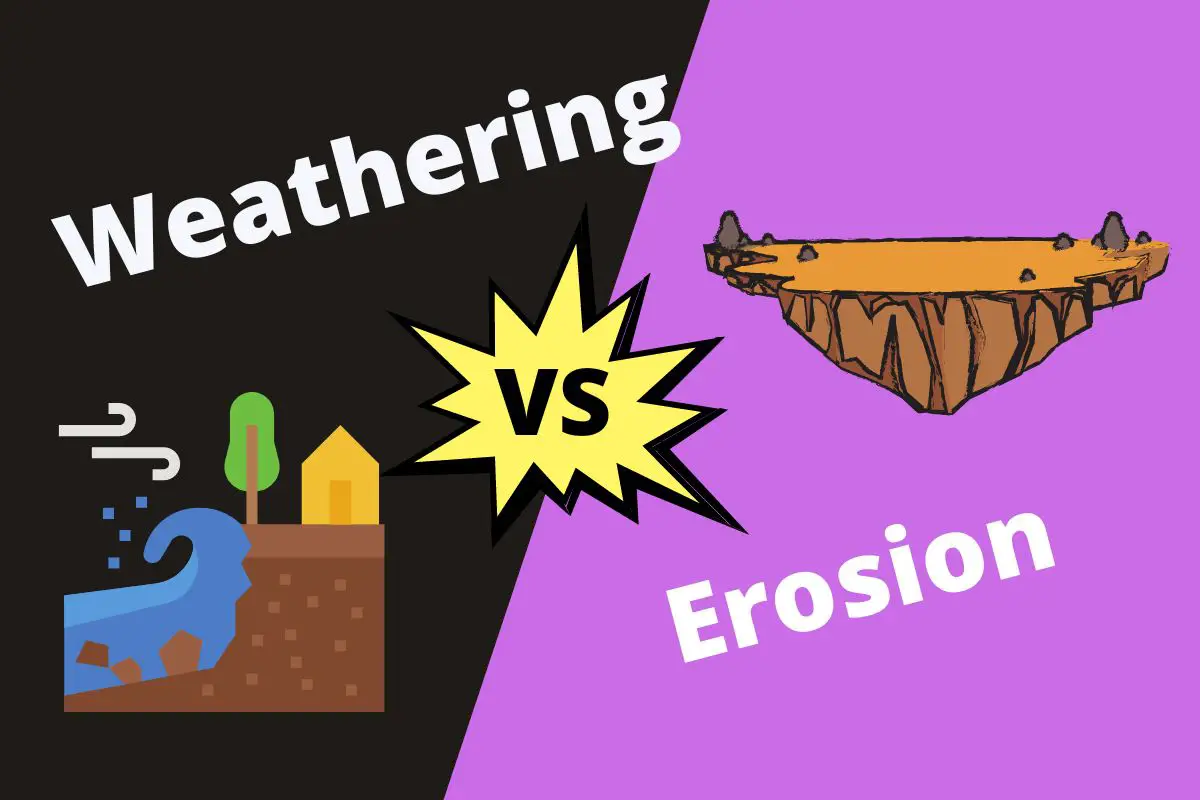The main difference between weathering and erosion is that weathering involves no movement of rock or soil particles. In comparison, erosion carries away rock and soil particles through wind, water, or ice.
You might know about weathering and erosion from your science books or environmental news. Overall, these two processes are similar, but they’re not the same.
Both weathering and erosion are common geological processes representing the depletion and degradation of soil on the surface of the Earth.
Table of Contents
Weathering vs Erosion
| Weathering | vs | Erosion |
| Atmospheric agents like air pressure | Causes | Wind, water, ice, and human activities |
| Physical, chemical, and biological | Types | Wind, water, and glacial |
| No displacement | Displacement | Undergo displacement |
| At the site of the rock | Location | Away from the original location |
What is Weathering?
Weathering is the degradation of rocks and minerals without displacement by direct contact with the atmosphere. No movement occurs in weathering, making it an in situ process.
Weathering can be caused by several atmospheric agents, such as:
- Water
- Acids
- Salts
- Plants
- Animal
- Temperature changes.

Types of Weathering
Weathering is classified into three types.
Physical Weathering
Physical weathering is also called mechanical weathering. It involves the depletion of soil layers by direct contact with atmospheric agents such as heat, water, ice, and pressure, but without any chemical change. Physical weathering can impact landforms by eroding coastal features.
Abrasion is the primary process of physical weathering. This weathering mainly occurs in areas with fewer or no plants, such as mountain regions and hot deserts.
Physical weathering is common in places that experience repeated melting and freezing of water or expansion and shrinking of rock surfaces caused by the sun.
Chemical Weathering
Chemical weathering occurs when soil degradation occurs by a chemical reaction of atmospheric gases and biologically produced chemicals with rocks, soils, and water.
In chemical weathering, rock’s original mineral forms into new or secondary minerals. The main processes in chemical weathering are oxidation and hydrolysis. These chemical reactions occur in warm and humid climates.
Biological Weathering
Biological weathering occurs when rocks get weakened by the activities of animals, plants, and microbes. Plant roots put pressure on the rocks, which makes them lose and weak. Then, weathering occurs via physical processes to break down the rocks into smaller pieces.
For example, the growth of lichen on the rock. Chemical weathering is also the result of biological processes.
What is Erosion?
Erosion is another common geological action in which rock, soil, or dissolved material are carried away by wind and water.
In erosion, particles are transported from one place to another. The erosion rate depends on many factors, including vegetation, the intensity of wind and rainwater, and soil composition.
Human activities such as excessive farming, land clearing, and deforestation lead to soil erosion.
Climatic fluctuation and temperature changes can also make the top layer of soil more vulnerable to erosion.
Erosion harms the land, making it less fertile, and it reduces the quality and quantity of the top layer of soil.

Types of Erosion
There are three types of erosion.
Water Erosion
In water erosion, as the name indicates, water is the leading cause of erosion. Moving water such as rainwater, river, and ocean play a significant role in displacing soil and rock materials from one location to another.
The lands where there is no vegetation are more prone to water erosion. This is because the roots absorb the water. Still, the soil becomes vulnerable to water erosion when there are no plants — extreme weather events such as flash floods and rapid snowmelt speed up erosion.
Wind Erosion
Wind erosion occurs when the wind blows away the smaller particles of soil and rock from one place to another. Its intensity depends on the power of the wind. Thus, strong winds such as storms speed up the process of erosion.
Besides displacing the top layer of soil, wind erosion also reduces air quality, leading to breathing difficulty.
Glacial Erosion
Glacial erosion occurs when an enormous amount of snowfall occurs on mountains and snow accumulates, leading to glaciers’ movement. The movement of heavy glaciers erodes the hill and picks everything like soil particles in its path.
Soil erosion and water erosion can cause landslides. Landslides occur when rocks and soil succumb to gravity or other elements pulling down on them.
Soil and wind are the most common of these three types of erosion, while glacial erosion isn’t common.
Weathering vs Erosion – Key Differences
Here are brief differences between weathering and erosion.
Causes
Weathering is caused due to atmospheric agents, primarily air pressure. On the other hand, erosion results from wind, water, ice, and human activities.
Types
Weathering is classified as physical, chemical, and biological. While wind, water, and glacial are the three main subtypes of erosion.
Displacement
In weathering, no rock and soil particle displacement occurs; however, soil and rock materials undergo removal from one place to another in erosion.
Location
Weathering takes place at the site of rock or minerals. Erosion takes place away from the original location.
The Impacts of Weathering and Erosion
Weathering and erosion both are harmful to the environment. And thus, these must be controlled at all levels.
While weathering leads to the breaking down of rock into soil particles, erosion displaces it away from the original place.
Ways to Prevent Soil Erosion
- Plant more and more trees
- Use Erosion Control Blankets
- Soil matting
- Turn the slope area into a flat surface
- Create diversions to help water drain in ideal places

